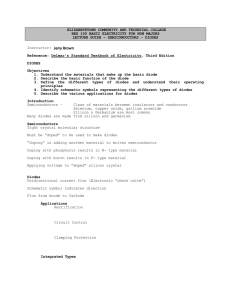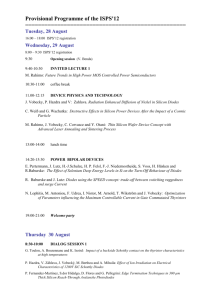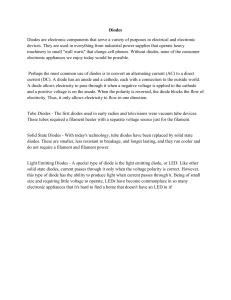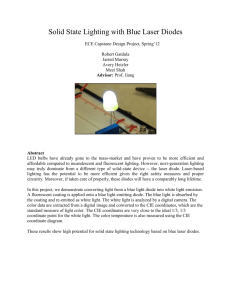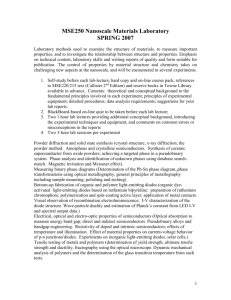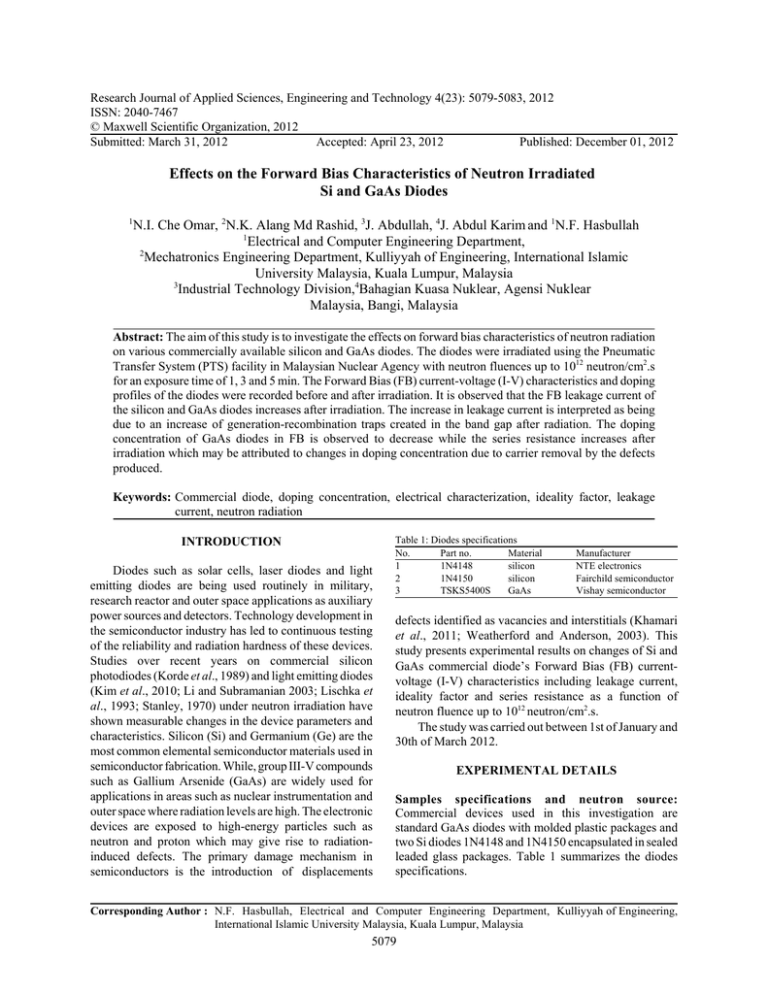
Research Journal of Applied Sciences, Engineering and Technology 4(23): 5079-5083, 2012
ISSN: 2040-7467
© Maxwell Scientific Organization, 2012
Submitted: March 31, 2012
Accepted: April 23, 2012
Published: December 01, 2012
Effects on the Forward Bias Characteristics of Neutron Irradiated
Si and GaAs Diodes
1
N.I. Che Omar, 2N.K. Alang Md Rashid, 3J. Abdullah, 4J. Abdul Karim and 1N.F. Hasbullah
1
Electrical and Computer Engineering Department,
2
Mechatronics Engineering Department, Kulliyyah of Engineering, International Islamic
University Malaysia, Kuala Lumpur, Malaysia
3
Industrial Technology Division,4Bahagian Kuasa Nuklear, Agensi Nuklear
Malaysia, Bangi, Malaysia
Abstract: The aim of this study is to investigate the effects on forward bias characteristics of neutron radiation
on various commercially available silicon and GaAs diodes. The diodes were irradiated using the Pneumatic
Transfer System (PTS) facility in Malaysian Nuclear Agency with neutron fluences up to 1012 neutron/cm2.s
for an exposure time of 1, 3 and 5 min. The Forward Bias (FB) current-voltage (I-V) characteristics and doping
profiles of the diodes were recorded before and after irradiation. It is observed that the FB leakage current of
the silicon and GaAs diodes increases after irradiation. The increase in leakage current is interpreted as being
due to an increase of generation-recombination traps created in the band gap after radiation. The doping
concentration of GaAs diodes in FB is observed to decrease while the series resistance increases after
irradiation which may be attributed to changes in doping concentration due to carrier removal by the defects
produced.
Keywords: Commercial diode, doping concentration, electrical characterization, ideality factor, leakage
current, neutron radiation
INTRODUCTION
Diodes such as solar cells, laser diodes and light
emitting diodes are being used routinely in military,
research reactor and outer space applications as auxiliary
power sources and detectors. Technology development in
the semiconductor industry has led to continuous testing
of the reliability and radiation hardness of these devices.
Studies over recent years on commercial silicon
photodiodes (Korde et al., 1989) and light emitting diodes
(Kim et al., 2010; Li and Subramanian 2003; Lischka et
al., 1993; Stanley, 1970) under neutron irradiation have
shown measurable changes in the device parameters and
characteristics. Silicon (Si) and Germanium (Ge) are the
most common elemental semiconductor materials used in
semiconductor fabrication. While, group III-V compounds
such as Gallium Arsenide (GaAs) are widely used for
applications in areas such as nuclear instrumentation and
outer space where radiation levels are high. The electronic
devices are exposed to high-energy particles such as
neutron and proton which may give rise to radiationinduced defects. The primary damage mechanism in
semiconductors is the introduction of displacements
Table 1: Diodes specifications
No.
Part no.
Material
1
1N4148
silicon
2
1N4150
silicon
3
TSKS5400S
GaAs
Manufacturer
NTE electronics
Fairchild semiconductor
Vishay semiconductor
defects identified as vacancies and interstitials (Khamari
et al., 2011; Weatherford and Anderson, 2003). This
study presents experimental results on changes of Si and
GaAs commercial diode’s Forward Bias (FB) currentvoltage (I-V) characteristics including leakage current,
ideality factor and series resistance as a function of
neutron fluence up to 1012 neutron/cm2.s.
The study was carried out between 1st of January and
30th of March 2012.
EXPERIMENTAL DETAILS
Samples specifications and neutron source:
Commercial devices used in this investigation are
standard GaAs diodes with molded plastic packages and
two Si diodes 1N4148 and 1N4150 encapsulated in sealed
leaded glass packages. Table 1 summarizes the diodes
specifications.
Corresponding Author : N.F. Hasbullah, Electrical and Computer Engineering Department, Kulliyyah of Engineering,
International Islamic University Malaysia, Kuala Lumpur, Malaysia
5079
Res. J. Appl. Sci. Eng. Technol., 4(23): 5079-5083, 2012
The diodes were irradiated with neutron fluences up
to 1012 neutron/cm2.s in the Reactor TRIGA PUSPATI
with power level at 750 kW using the Pneumatic Transfer
system in Malaysian Nuclear Agency, Bangi, Malaysia.
Irradiation was performed on three devices of each part
number to ensure reproducibility of the measurements. All
diodes were labeled accordingly and inserted one by one
into capped Polyethylene (PE) vials before irradiation to
avoid contamination. The exposure times for each type of
diode were 1, 3 and 5 min. The PTS system is meant for
short irradiation purposes with a maximum exposure time
of 5 min. For each exposure time, three vials were
inserted into a particular capsule for the transmission into
ring G20 of the reactor core.
-2
10
(a)
-3
10
Current (A)
-4
10
-5
10
-6
No radiation
1 min
2 min
3 min
10
-7
10
-8
10
-9
10
0.0
-2
10
0.2
0.4
Voltage (V)
0.6
(b)
-3
10
Measurements: The electrical measurements were
carried out in the Electronics Systems laboratory at
International Islamic University Malaysia. FB I-V
measurements were performed at room temperature in a
dark enclosure using Keithley 4200 Semiconductor
Characterisation System (SCS) before and after
irradiation. For each sample, the measurements were
repeated three times to ensure reproducibility. FB I-V
characteristics of 1N4148 (Si) and 1N4150 (Si) diodes
were measured three days after irradiation while
measurements on TSKS5400S (GaAs) diodes were
performed one week later to allow radioactivity to reach
acceptable safety level.
Current (A)
-4
10
-5
10
-6
-7
10
-8
10
-9
10
Current (A)
0.0
RESULTS AND DISCUSSION
In this study we present some results which are
representative for the selected devices. The cross sectional
areas for all devices are unknown although requested from
manufacturers. Figure 1 consist of three graphs where
Fig. 1a shows semi-log FB I-V characteristics of the
1N4148 (Si), Fig. 1b for 1N4150 (Si) diodes and Fig. 1c
for the TSKS5400S (GaAs) diodes. All devices show an
increase in FB leakage current after neutron irradiation.
This is expected as radiation-induced defects are
introduced in the diodes. This will cause an increase of
Generation-Recombination (GR) current in the devices
and increase the leakage current of the devices
(Hajghassem et al., 1992; Horváth et al., 1999;
Weatherford and Anderson, 2003). Figure 1 a and b show
that the increase of leakage current for the Si diodes are
minimal compared to the GaAs diodes in Fig. 1c. Figure
2 further illustrates the differences in current increment
where the percentage current increment is plotted against
exposure time.
Figure 2 shows a semi-log plot of percentage current
increment plotted with respect to exposure time taken at
reference voltage of 0.5V. The percentage current
increment is obtained by calculating the percentage
difference in FB leakage current magnitude before and
No radiation
1 min
3 min
5 min
10
102 (c)
103
4
10 Increasing
105 exposure
6
time
10
7
10
8
109
10
10
10
11
10
12
10
1013
1014
0.0
0.2
0.4
Voltage (V)
0.6
No radiation
1 min
2 min
3 min
0.2
0.4
Voltage (V)
0.6
Fig. 1: FB leakage currents for unirradiated devices and
irradiated devices exposed for 1, 3 and 5 min for (a)
1N4148 silicon diodes, (b) 1N4150 silicon diodes and,
(c) TSKS5400 GaAs diodes, respectively
after irradiation. Generally, it can be seen that there is a
linear increase in the diode FB leakage current for all
devices as the exposure time increases. This is expected
as the rate of reaction induced by neutrons is defined as
N(r)G where, N (r) is the neutron flux (length-2 time-1) and
G is the macroscopic cross section (Knoll, 2000). Thus, an
increase in exposure time increases the reaction rate and
radiation-induced defect density. This is manifested by the
increase of leakage currents in the devices. As exposure
time increases the rate of GR also increases because there
are more defects in the semiconductor lattice. Several
studies (Chih-Tang et al., 1957; Hasbullah et al., 2011;
Sanchez et al., 2009) suggested that FB leakage current
correlates with defect density where GR leakage current,
IGR is proportional to qWF<thNtni with q being the
5080
Percentage current increment (%)
Res. J. Appl. Sci. Eng. Technol., 4(23): 5079-5083, 2012
107
Table 2: Parameters for TSKS5400 GaAs diode
Exposure time
(min)
Irradiation
Is (pA)
n
1
before
0.0676
1.732
1
after
14.200
1.820
3
before
0.0543
1.693
3
after
53.100
1.872
5
before
0.0516
1.709
5
after
101.50
1.898
1N4148
1N4150
TSKS5400S
6
10
5
10
4
10
3
10
2
10
Rs (S)
0.68
6.92
6.87
7.82
1.12
15.98
1
10
0
ideality factor, n and saturation current, IS can be
extracted from the FB I-V characteristics by fitting the
linear region of the plot to the approximated ideal diode
equation.
10
-1
10
0
1
2
3
4
Exposure time (min)
5
6
Fig. 2: Percentage current increment of all diodes at 0.5 V bias
with different neutron exposure time. The solid lines are
a guide to the eyes
electronic charge, W is the thickness of the intrinsic
region, F is the electron and hole capture cross section, <th
is the thermal velocity, Nt the defect density and ni is the
intrinsic carrier concentration.
Results from Fig. 2 indicates that the GaAs diodes
suffer more degradation compared to the Si diodes. This
is unusual compared to other studies reported where
Wysocki (1963) discovered that GaAs cells to be superior
to Si cells in a radiation field of high-energy particles. It
was also reported that GaAs devices are more resistant to
defects due to neutron irradiation compared to Si devices
(Weatherford and Anderson, 2003).
This may be explained by the fact that the silicon
diodes used in this experiment are switching diodes. It is
known that gold (Au) doping is used in switching diodes
to improve its speed (Streetman and Banerjee, 2010; Sze
and Ng, 2007). A recent technical report by Sandia
National Laboratories states that gold doping is used in
1N4148 (Si) diodes (Loubriel et al., 2012). It was reported
by McPherson et al. (1997) that gold doping in silicon
may reduce the effects of neutron irradiation. Present
vacancies in the silicon lattice are believed to be occupied
by the gold atoms thus restricting the formation of other
energy levels in the bandgap. A similar effect was
obtained by Cappelletti et al. (2009) on gold-doped
silicon photodiodes comparing simulated results with
experimental data. They suggested that gold atoms filling
the vacancies prevent formation of neutron-induced defect
levels near the midband gap. Thus, we believe that the
gold-doping in our silicon diodes is the possibility that
suppresses the increase in leakage current after
irradiation.
Further analysis can be done by studying the ideality
factor, n where it is a measure of the deviation from the
ideal diode characteristics. The diode is considered ideal
if n = 1 where the dominant mechanism is diffusion and
if n = 2 the dominant mechanism is GR. Both diffusion
and GR processes may occur simultaneously in the device
when the values of n are between 1 and 2. The diode
⎡
⎛ qV ⎞ ⎤
I ≈ I s ⎢ exp⎜
⎟
⎝ nkT ⎠ ⎥⎦
⎣
(1)
where, I is the forward current, q is the electronic charge,
V is the voltage applied, k is the Boltzmann’s constant and
T is the temperature. The Is and n extracted from a
representative fit of the TSK5400S GaAs diode irradiated
for 5 min are 1.015x10-10A and 1.898, respectively.
Values of the saturation current and ideality factor for all
exposure time recorded for TSK5400S GaAs diodes are
shown in Table 2. There appears to be a systematic
increase in the ideality factor and the saturation current as
the exposure time increases.
The increase in FB leakage current, Is and n may be
attributed to the introduction of recombination centres
introduced by the creation of defects in the semiconductor
structure by radiation-induced displacement damages
(Weatherford and Anderson, 2003). Displacement
damages occur when neutron particles collide with an
atom of a nucleus and displace the atom from their normal
position in the lattice thus creating interstitial or vacancy
defects. These defects act as effective recombination and
trapping centres which create additional levels within the
band gap assisting emission of electrons and holes thus
increasing the leakage current.
The high current region of the FB I-V characteristics
in Fig. 1c shows substantial changes with exposure time.
This is interpreted as a change in the series resistance of
the material. The series resistance, Rs of GaAs diodes
before and after 1, 3 and 5 min neutron irradiation is
obtained by fitting the high injection region of the FB I-V
curve to the ideal diode equation, where thermal voltage,
Vt, is equal to kT/q.
⎡
⎤
⎛ V − I . Rs ⎞
⎟ − 1⎥
I = I s ⎢ exp⎜
nV
⎝
⎠
t
⎣
⎦
(2)
The values of n and Is previously obtained in Table 2
were used by fitting only the value of Rs. The values of
series resistance of the GaAs diodes are tabulated in
Table 2 where Rs is observed to increase after irradiation.
5081
Relative dropping concentration (arb)
Res. J. Appl. Sci. Eng. Technol., 4(23): 5079-5083, 2012
No radiation
5
5 min radiation
4
3
2
1
0
2
4
6
8
10 12
Depth (min)
14
16
18
20
Fig. 3: The doping concentration against depletion width of
GaAs diodes before and after 5 min irradiation. The
solid lines are a guide to the eye
Previous studies have discussed such effects where a
study by Korde et al. (1989) reported that the increase in
Rs was due to the increase in bulk resistivity of the device
caused by a decrease in the doping density due to carrier
removal after neutron exposure. The increase in Rs can be
further explained by the changes in the doping profile of
the GaAs diodes. Harris et al. (2005) stated that series
resistance of a diode is inversely proportional to the
dopant density where Rs = C/ND (Sze and Ng, 2007). ND
is the dopant density and C is a constant depending on the
relation of ND and Rs. The doping concentration and width
of depletion region are extracted from the CapacitanceVoltage (C-V) measurements with one sided abrupt
junction assumption. The values of doping concentration
are represented as relative doping concentration since the
cross sectional area of the diodes were not provided by
the manufacturer.
Figure 3 shows at a fixed depletion width, the relative
doping concentration halves after irradiation. This is
interpreted due to changes in the effective doping
concentration known as carrier removal (Czerwinski et
al., 2003; Williams et al., 1991). Carrier removal is one of
the effects of displacement damage in the diode after
neutron irradiation. Another effect of displacement
damage is type conversion or carrier compensation where
after irradiation the samples become intrinsic observed
after neutron irradiation due to carrier removal
(Moscatelli et al., 2006; Weatherford and Anderson,
2003). The fluence of up to 1012 neutron cm2.s is
insufficient to make the material of the diodes intrinsic.
CONCLUSION
The results presented in this study show that both
silicon and GaAs diodes experienced increase in FB
leakage current after neutron irradiation. This is
interpreted due to the neutron-induced defects creating
more mid band traps hence the increase of the FB leakage
current. Silicon diodes shows less degradation compare to
GaAs diodes due to gold doping in the diode which
suppresses neutron-induced defects. The saturation
current, ideality factor and series resistance increases in
all devices suggest that defects increase in devices after
irradiation. It is also found that series resistance increase
with exposure time due to carrier removal induced by
displacement defects. Diodes may continue to evolve in
the near future and there will always be a need to do basic
evaluations of new diode types as radiation effects may
differ for other types of diodes.
ACKNOWLEDGMENT
The authors wish to acknowledge the cooperation of
Mr. Mohammad Suhaimi Kassim from the Nuclear Power
Division, Malaysian Nuclear Agency in providing the
facilities. We would also like to thank International
Islamic University Malaysia (EDW B11-010-0488) and
Malaysia Toray Science Foundation for financial support.
REFERENCES
Cappelletti, M.A., A.P. Cedola, S. Baron, G.Casas and
E.L. Peltzer y Blanca, 2009. Study of radiation
effects on PIN photodiodes with deep-trap levels
using computer modeling. Test Workshop, LATW
'09. 10th Latin American, pp: 1-6.
Chih-Tang, S., R.N. Noyce and W. Shockley, 1957.
Carrier generation and recombination in P-N
junctions and P-N junction characteristics. Proc. IRE,
45(9): 1228-1243.
Czerwinski, A., E. Simoen, A. Poyai, C. Claeys and H.
Ohyama, 2003. Gated-diode study of corner and
peripheral leakage current in high-energy neutron
irradiated silicon p-n junctions. IEEE T. Nucl. Sci.,
50(2): 278-287.
Hajghassem, H.S., W.D. Brown and J.G. Williams, 1992.
Modeling the effects of neutron irradiation on LEDs.
Solid-State Electr., 35(1): 51-55.
Harris, R.D., A.J. Frasca and M.O. Patton, 2005.
Displacement damage effects on the forward bias
characteristics of SiC Schottky barrier power diodes.
IEEE T. Nucl. Sci., 52(6): 2408-2412.
Hasbullah, N.F., J.P.R. David and D.J. Mowbray, 2011.
Dark current mechanisms in quantum dot laser
structures. J. Appl. Phys., 109(11): 113111-11-5.
Horváth, Z.J., E. Gombia, D. Pal, C. Kovacsics,
G.Capannese, et al., 1999. Effect of defect bands on
the electrical characteristics of irradiated GaAs and
Si. Phys. Status Solidi (A), 171(1): 311-317.
5082
Res. J. Appl. Sci. Eng. Technol., 4(23): 5079-5083, 2012
Khamari, S.K., V.K. Dixit, T. Ganguli, S. Porwal, S.D.
Singh, et al., 2011. Effect of 60Co (-ray irradiation
on electrical properties of GaAs epilayer and GaAs pi-n diode. Nucl. Instrum. Method. Phys. Res., B,
269(3): 272-276.
Kim, H.Y., J. Kim, F. Ren and S. Jang, 2010. Effect of
neutron irradiation on electrical and optical properties
of InGaN/GaN light-emitting diodes. J. Vacuum Sci.
Techn. B, 28(1): 27-29.
Knoll, G.F., 2000. Radiation Detection and Measurement.
Wiley, New York.
Korde, R., A. Ojha, R. Braasch and T.C. English, 1989.
The effect of neutron irradiation on silicon
photodiodes. IEEE T. Nucl. Sci., 36(6): 2169-2175.
Li, C. and S. Subramanian, 2003. Neutron irradiation
effects in GaN-based blue LEDs. IEEE T. Nucl. Sci.,
50(6): 1998-2002.
Lischka, H., H. Henschel, O. Kohn, W. Lennartz and
H.U. Schmidt, 1993. Radiation effects in light
emitting diodes, laser diodes, photodiodes and
optocouplers. Second European Conference on
Radiation and its Effects on Components and
Systems, RADECS 93, pp: 226-31.
Loubriel, G.M., et al., 2012. Extremely high frequency
RF effects on electronics. Medium: ED; Size, pp: 51.
McPherson, M., T. Sloan and B.K. Jones, 1997.
Suppression of irradiation effects in gold-doped
silicon detectors. J. Phys. D Appl. Phys., 30(21):
3028-3035.
Moscatelli, F., A. Scorzoni, A. Poggi, M. Bruzzi, S.
Sciortino, et al., 2006. Radiation hardness after very
high neutron irradiation of minimum ionizing particle
detectors based on 4H-SiC p+n junctions. IEEE T.
Nucl. Sci., 53(3): 1557-1563.
Sanchez, A.M., R. Beanland, N.F. Hasbullah, M.
Hopkinson and J.P.R. David 2009. Correlation
between defect density and current leakage in
InAs/GaAs quantum dot-in-well structures. J. Appl.
Phys., 106(2): 024502-06.
Stanley, A.G., 1970. Comparison of light emitting diodes
in a space radiation environment. IEEE T. Nucl. Sci.,
17(6): 239-244.
Streetman, B.G. and S.K. Banerjee, 2010. Solid State
Electronic Devices. Pearson Prentice Hall, pp: 10.
Sze, S.M. and K.K. Ng, 2007. Physics of Semiconductor
Devices. 3rd Edn., Wiley-Interscience, Hoboken, NJ.
Weatherford, T.R. and W.T. Anderson Jr., 2003.
Historical perspective on radiation effects in III-V
devices. IEEE T. Nucl. Sci., 50(3): 704-710.
Williams, J.G., J.U. Patel, A.M. Ougouag and S.Y. Yang,
1991. Carrier removal and changes in electrical
properties of neutron irradiated GaAs. J. Appl. Phys.,
70(9): 4931.
Wysocki, J.J., 1963. Radiation studies on GaAs and Si
devices. IEEE T. Nucl. Sci., 10(5): 60-65.
5083

